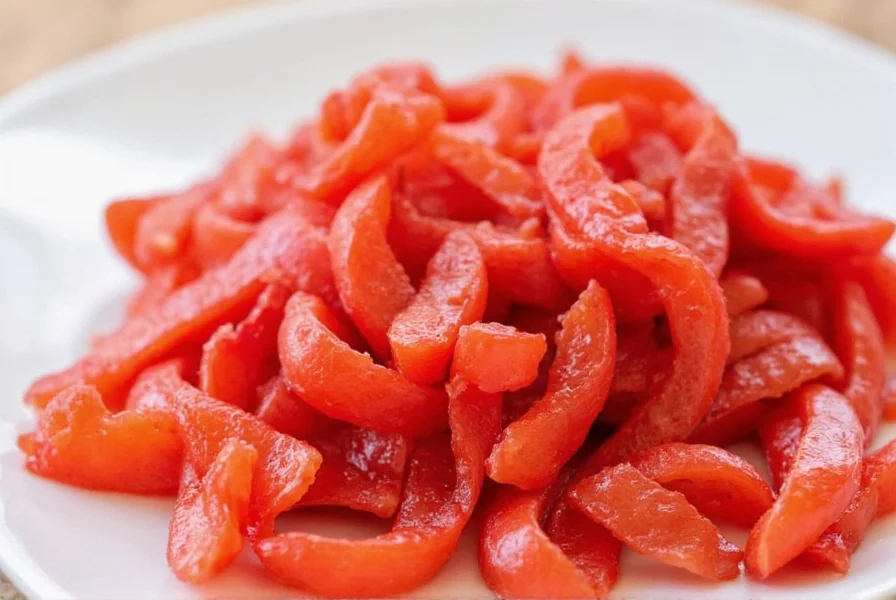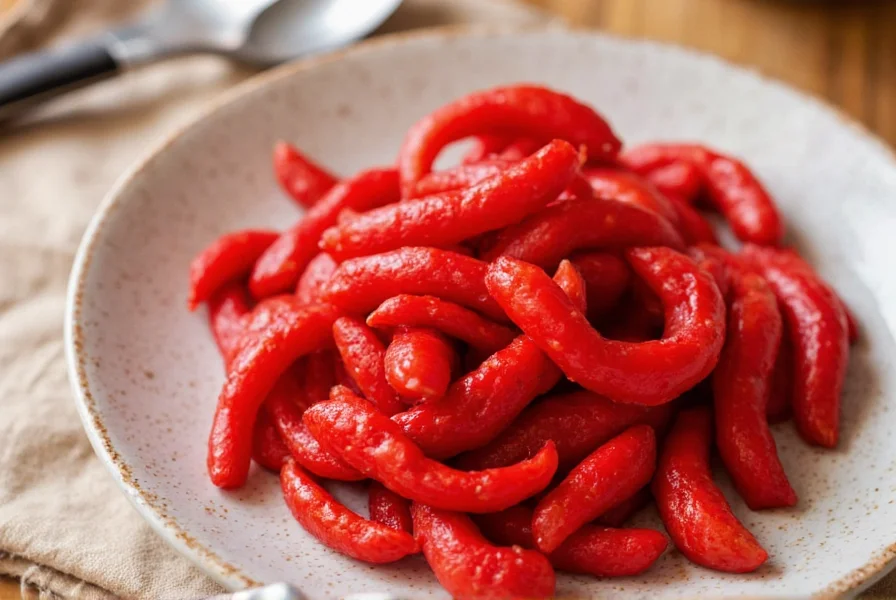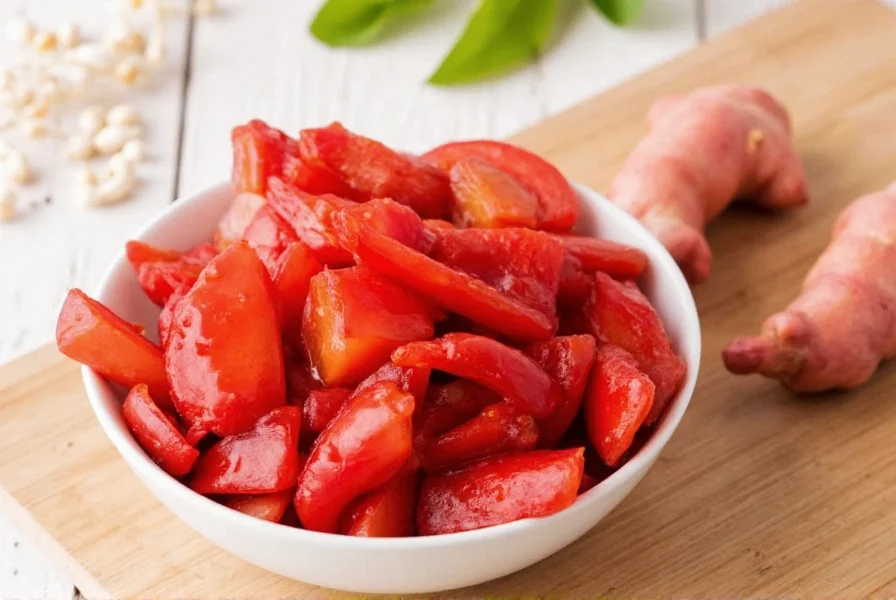Pickled red ginger represents one of the most distinctive elements of Japanese culinary tradition, particularly in sushi service. Unlike mature ginger used in cooking, pickled red ginger utilizes young spring ginger with thin skin and tender flesh that readily absorbs the pickling solution while developing its characteristic pink color. This transformation occurs naturally when the anthocyanin pigments in young ginger interact with the acidic vinegar environment—a process that takes several days to complete.
The Science Behind the Pink Color
Many people mistakenly believe that artificial coloring creates pickled ginger's pink hue. In reality, the color development depends on three key factors:
| Factor | Role in Color Development | Optimal Condition |
|---|---|---|
| Ginger Age | Young ginger contains anthocyanins | Spring harvest (March-May) |
| Vinegar Acidity | Triggers anthocyanin reaction | 4-5% acidity rice vinegar |
| Resting Time | Allows color to develop gradually | 3-7 days at room temperature |
Commercial producers sometimes add umeboshi (pickled plum) vinegar to accelerate the natural pinkening process, as it contains higher concentrations of the necessary pigments. This practice remains completely natural and distinguishes authentic pickled ginger from artificially colored imitations.

Distinguishing Gari from Beni Shoga
Two primary types of pickled ginger appear in Japanese cuisine, often confused by Western diners:
- Gari - Sliced paper-thin, sweetened significantly, pale pink, served as sushi palate cleanser
- Beni Shoga - Shredded, less sweet, brighter red, used as topping for okonomiyaki and yakisoba
The difference between gari and beni shoga extends beyond appearance. Gari's delicate sweetness complements raw fish without overpowering it, while beni shoga's stronger ginger flavor and acidity cut through richer dishes. Understanding this distinction helps home cooks select the appropriate variety for different culinary applications when exploring traditional Japanese recipes.
Culinary Applications Beyond Sushi
While most Westerners encounter pickled red ginger exclusively with sushi, Japanese cuisine utilizes it in diverse ways:
- As a condiment for rice bowls (donburi)
- Added to noodle dishes for brightness
- Paired with fatty fish like mackerel
- Used in modern fusion sandwiches for acidity
- Incorporated into salad dressings for complexity
Chefs increasingly recognize pickled ginger's versatility in non-Asian contexts. Its bright acidity works well with rich foods, making it an excellent accompaniment to duck, pork belly, or even certain cheeses. When experimenting with pickled red ginger substitutes, note that regular pickled ginger lacks the visual appeal and slightly different flavor profile that makes the red variety distinctive.
Health Benefits Supported by Research
Ginger's medicinal properties have been documented for centuries, and pickling preserves many beneficial compounds while enhancing others:
- Digestive aid - Gingerols stimulate digestive enzymes, helping break down proteins
- Antioxidant boost - The pickling process increases certain antioxidant compounds
- Nausea relief - Effective for motion sickness and morning sickness (studies show 1g daily)
- Anti-inflammatory effects - Gingerols may reduce inflammation markers
A 2022 review in the Journal of Food Science and Technology confirmed that pickling preserves 70-80% of fresh ginger's active compounds while increasing certain phenolic acids through the fermentation process. However, the sugar content in commercial varieties means moderation remains advisable for those monitoring sugar intake.

Simple Homemade Preparation
Creating authentic pickled red ginger at home requires minimal ingredients but attention to timing:
- Peel and thinly slice 200g young ginger (use mandoline for paper-thin slices)
- Soak slices in 1/4 cup salt for 2 hours to draw out moisture
- Prepare pickling solution: 1 cup rice vinegar, 1/2 cup sugar, 1/4 cup water
- Simmer solution until sugar dissolves, then cool completely
- Place ginger in sterilized jar, cover with solution
- Store at room temperature for 3 days before refrigerating
The resulting homemade pickled red ginger will develop a natural pale pink color within 48-72 hours. For deeper color without artificial dyes, add 2 tablespoons umeboshi vinegar to the pickling solution. Properly stored in the refrigerator, homemade pickled ginger maintains quality for 6-8 months.
Storage and Shelf Life Considerations
Understanding proper storage extends the usability of both commercial and homemade pickled ginger:
- Unopened commercial jars last 1-2 years in pantry
- Refrigerate after opening (all varieties)
- Use clean utensils to prevent contamination
- Discard if mold appears or vinegar becomes cloudy
- Color may fade over time but remains safe to eat
When evaluating pickled ginger shelf life, trust your senses over printed dates. Properly pickled ginger maintains safety through acidity, but quality degrades over time. The ginger should remain firm with a clean, tangy aroma. Softening or off-odors indicate spoilage.
Common Misconceptions Clarified
Several myths persist about this traditional condiment:
- Myth: The pink color comes from artificial dyes
- Fact: Natural reaction between young ginger's anthocyanins and vinegar
- Myth: All pink ginger is the same product
- Fact: Gari (sweet sushi ginger) differs significantly from beni shoga (shredded topping)
- Myth: Pickling destroys ginger's health benefits
- Fact: Many beneficial compounds remain stable or increase during pickling
Understanding these distinctions helps consumers make informed choices when selecting authentic pickled red ginger products or preparing it at home. The growing popularity of Japanese cuisine has led to more accurate representations in Western markets, though reading ingredient labels remains advisable to avoid artificially colored versions.
Frequently Asked Questions
Why is pickled ginger pink naturally?
The pink color develops naturally when anthocyanins in young spring ginger react with the acidic vinegar solution during pickling. No artificial coloring is needed when using proper young ginger and traditional preparation methods.
What's the difference between gari and beni shoga?
Gari is thinly sliced, sweetened pickled ginger served with sushi as a palate cleanser, while beni shoga is shredded, less sweet, and used as a topping for dishes like okonomiyaki. Gari has a milder flavor and paler pink color compared to the brighter red beni shoga.
How long does homemade pickled ginger last?
Properly prepared and stored in the refrigerator, homemade pickled ginger maintains quality for 6-8 months. The vinegar solution preserves it, but quality gradually declines over time. Always use clean utensils when serving to prevent contamination and spoilage.
Does pickled ginger have health benefits?
Yes, pickled ginger retains many of fresh ginger's health benefits including digestive support, nausea relief, and anti-inflammatory properties. The pickling process preserves 70-80% of active compounds while increasing certain antioxidants. However, commercial varieties contain added sugar, so moderation is advised.











 浙公网安备
33010002000092号
浙公网安备
33010002000092号 浙B2-20120091-4
浙B2-20120091-4